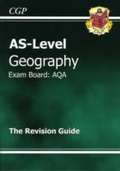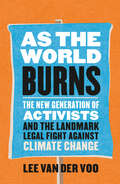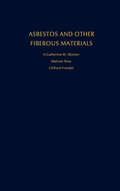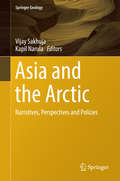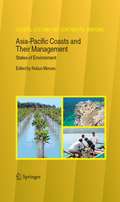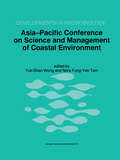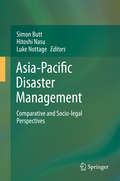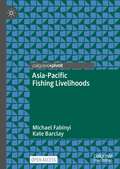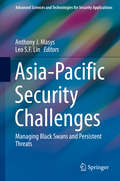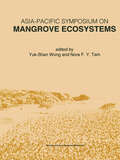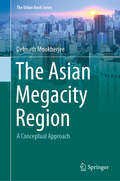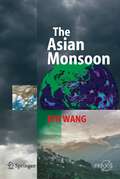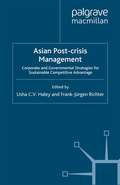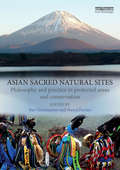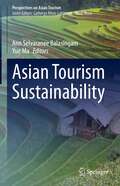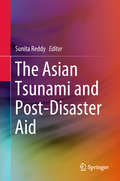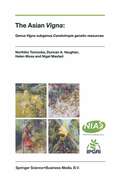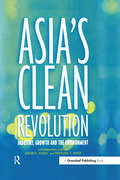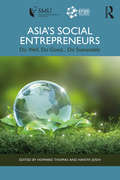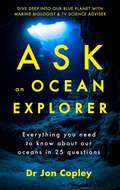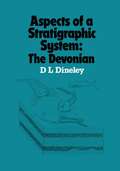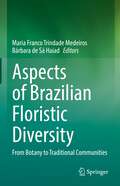- Table View
- List View
AS Level Geography AQA Complete Revision & Practice (PDF)
by Cgp BooksThis Revision Guide contains comprehensive study notes for AS-Level Geography, perfectly matched to the AQA specification. Exam-style practice questions are also included for every topic. Everything's presented in an accessible, student-friendly style, with plenty of clear diagrams and a touch of humour.
As the World Burns: The New Generation of Activists and the Landmark Legal Fight Against Climate Change
by Lee van der VooAward-winning investigative journalist Lee van der Voo reports on Juliana v. the United States. Combining unparalleled access to the plaintiffs and reporting on the natural disasters that form an urgent backdrop to the story, van der Voo shares a timely and important story about the environment, the law, and the new generation of activists.
Asbestos and Other Fibrous Materials: Mineralogy, Crystal Chemistry, and Health Effects
by H. Catherine Skinner Malcolm Ross Clifford FrondelThis comprehensive sourcebook describes the chemical, physical, and mineralogical aspects of fibrous inorganic materials, both synthetic and naturally occurring. A general description of the fibrous state, the range of compounds that can adopt this form, and an overview of the characteristics unique to such materials form the backbone of the book . The authors also assess the application and use of asbestos and other fibrous materials in industry and evaluate their potential as health hazards. The information gathered here will be highly useful to medical investigators and legal professionals involved in environmental health.
Asia and the Arctic: Narratives, Perspectives and Policies (Springer Geology)
by Vijay Sakhuja Kapil NarulaThis book presents narratives, perspectives and policies on the Arctic and brings to fore the strategies of five Asian countries - China, India, Japan, Republic of Korea and Singapore who were granted the status of Permanent Observers in the Arctic Council in 2013. The book also captures Arctic countries’ reactions to Asian approaches, and their expectations from these countries. The melting of the polar sea-ice induced by climate change has placed the Arctic region in the forefront of global scientific, economic, strategic and academic interest. The discourse involves a number of issues such as claims of the littoral countries to the continental shelves of the region, the management and exploitation of its living and non-living resources, the rights and interests of indigenous communities, and the prospects of new ice-free shipping routes. The contemporary discourse also suggests that the Arctic region presents challenges and offers opportunities for the international community. These issues have given rise to new geopolitical, geoeconomic, and geostrategic dynamics amongst the Arctic littorals, and led to the growing interest of non-Arctic states in the affairs of the Arctic. It is evident that the Asian countries have a variety of interests in the Arctic, and the grant of Permanent Observer status to these countries is an acknowledgement of their capabilities. These countries are keen to explore opportunities in the Arctic, and have begun to formulate appropriate long-term national strategies. The preliminary approach of the Asian Observer countries has rightly been to graduate from ‘involvement’ to ‘engagement’ in the Arctic, which seems to have generated significant interest amongst analysts. This book helps to understand the approaches of various Arctic and non-Arctic stakeholders, in light of the evolving dynamics in the region.
Asia-Pacific Coasts and Their Management: States of Environment (Coastal Systems and Continental Margins #11)
by Nobuo MimuraThe Asia and Pacific region is home to the world’s largest concentration of coral reefs and mangroves. It accommodates two-thirds of the world’s human population and its economic activities have the highest growth rate in the world. This book gives an overview of the state-of-the-art understanding on the drivers, state, and responses to the coastal environmental changes in the Asia and Pacific region. It provides important perspectives on the subject for researchers.
Asia-Pacific Conference on Science and Management of Coastal Environment: Proceedings of the International Conference held in Hong Kong, 25–28 June 1996 (Developments in Hydrobiology #123)
by Yuk-Shan Yuk-Shan Wong Nora Fung-Yee TamHuman beings have a long historical relationship with the coast. Initially it provided food and security, later forming important locations for industrial and commercial development. Now the emphasis has shifted towards leisure and conservation, although the former functions remain crucial. However, it is only very recently that people have started viewing the coast as a common and valuable resource that requires rational utilisation and scientific management in order to sustain its attractiveness. Of course, enlightened management comes only through understanding of the complicated coastal regions, which enables coastal managers to balance pressures from different sectors and to minimize risks. Scientific knowledge will continue to be the most important basis for resolving the conflicts between coastal users and interest groups such as developers and ecologists. Coastal management has also shifted from traditional restorative or remedial actions towards planned avoidance of other conflicts. Despite rapid advancement in coastal sciences over recent decades, most of the major coastal issues have remained outstanding in the agenda. Control of shoreline erosion and protecting sea level rise continue to be crucial problems facing coastal scientists. Destructive coastal storms still cause tremendous damage, particularly in low altitudes. Wetland and estuary reclamation have led to the loss of the most valuable estuary wetlands which are required to sustain biological productivity and biodiversity. This volume includes papers on marine and coastal pollution, eutrophication, aquaculture, conservation and utilization, coastal wetlands, and coastal zone management.
Asia-Pacific Disaster Management: Comparative and Socio-legal Perspectives
by Simon Butt Hitoshi Nasu Luke NottageThe book outlines the regulatory environment for disaster prevention and management in broad social, economic and political context. The first half of the book focuses mainly on Japan, especially the ‘3-11’ events: the earthquake and tsunami that devastated the Tohoku area on 11 March 2011 and the Fukushima Daiichi nuclear power plant radiation leaks. The second half focuses on the USA (the only other Asia-Pacific country to have experienced a serious nuclear emergency), Indonesia, China, New Zealand, Australia and international law. One question explored is whether socio-legal norms play different roles in preventing and managing responses to natural disasters compared to ‘man-made’ disasters. Another is how ‘disaster law’ interacts with society across very diverse societies in the disaster-prone Asia-Pacific region. The book also addresses the increasingly important roles played by international law and regional regimes for cross-border cooperation in disaster prevention and relief, including the functions played by military forces.Erudite, pragmatic, and charged with detailed, substantive knowledge of an astonishing range of contexts and research fields, this timely collection of important essays on the law and society of disaster management stands as an exemplary international academic response to the disasters of 11 March 2011. (Annelise Riles)
Asia-Pacific Fishing Livelihoods
by Michael Fabinyi Kate BarclayThis open access book explores fishing livelihoods in the context of the wider contexts in which they are embedded. Drawing on case studies from across the Asia-Pacific region, the book highlights how fishing livelihoods are shaped by globalisation, social relationships and governance. The book concludes by showing how better understanding these relationships can contribute to governance for healthier ecosystems and social wellbeing.This is an open access book.This is an open access book.
Asia-Pacific Security Challenges: Managing Black Swans and Persistent Threats (Advanced Sciences and Technologies for Security Applications)
by Anthony J. Masys Leo S.F. LinThis edited book examines the contemporary regional security concerns in the Asia-Pacific recognizing the ‘Butterfly effect’, the concept that small causes can have large effects: ‘the flap of a butterfly’s wings can cause a typhoon halfway around the world’. For many Asia-Pacific states, domestic security challenges are at least as important as external security considerations. Recent events (both natural disasters and man-made disasters) have pointed to the inherent physical, economic, social and political vulnerabilities that exist in the region. Both black swan events and persistent threats to security characterize the challenges within the Asia-Pacific region. Transnational security challenges such as global climate change, environmental degradation, pandemics, energy security, supply chain security, resource scarcity, terrorism and organized crime are shaping the security landscape regionally and globally. The significance of emerging transnational security challenges in the Asia-Pacific Region impact globally and conversely, security developments in those other regions affect the Asia-Pacific region.
Asia-Pacific Symposium on Mangrove Ecosystems: Proceedings of the International Conference held at The Hong Kong University of Science & Technology, September 1–3, 1993 (Developments in Hydrobiology #106)
by Yuk-Shan Yuk-Shan Wong Nora F. Y. TamMangrove ecosystems are typical formations found in coastal deposits of mud and silt throughout the tropics and some distance into the subtropical latitudes. The total wordwide mangrove area, which is estimated at about 170,000 km2 with some sixty species of trees and shrubs exclusive to the habitat, dominates approximately 75% of the world's coastline between latitudes 25°N and 25°S. Such unique intertidal ecosystems support genetically diverse communities of terrestrial and aquatic organisms that are of direct or indirect socioeconomic values. Mangrove forests play important roles as coastal stabilization and protection against winds and storms; producers of nutrients, forest resources and animal species of economic importance. Recently, the issues on the conservation, proper utilization and management of mangrove forests have been widely discussed. Unfortunately, overexploitation and destruction of mangroves seriously threatens the sustainability of such a unique ecosystem. This volume includes papers on three main areas: recent advances in mangrove ecology; application and utilization of mangrove resources; and conservation and management of the ecosystems.
The Asian Megacity Region: A Conceptual Approach (The Urban Book Series)
by Debnath MookherjeeThis book argues that close and disciplined scrutiny of the Asian megacity regions is of critical importance to understanding Asian urbanization. However, any approach to studying these regions must adopt a multi-dimensional and trans-urban perspective; otherwise, we Without such an approach, we cannot truly make meaningful decisions about growth management and sustainable development for such regions. Amidst the sweeping demographic and structural shifts produced by global urbanization, Asian urbanization has a fascinating and prominent role. Asian urbanization is heterogeneous, and more accurately constitutes “phenomena” than a “phenomenon.” However, despite this diversity, there are certain common features that we can identify. One of them is the Asian “megacity region”— the administrative and/or delineated territory of mixed urban-rural landscape surrounding a giant metropolis.The purpose of this book is to: Understand the main features of 21st century urbanization Note the limitations of current approaches (e.g. disparate scales, city-centric views, inadequate data sets)Articulate a pragmatically framed three-pronged approach (scale-based, trans-urban, multi-dimensional)Demonstrate the application of such an approach with a case study of one of the most important megacity regions in South Asia, the Delhi National Capital Region, underscoring the methodological requirements of such an approach Discuss the next steps for the field as a whole: questions to be raised and directions to be explored for further study. This timely, conceptual and empirical book will appeal to students of urbanization, architects involved in urban policy and planning, and researchers alike.
The Asian Monsoon (Springer Praxis Books)
by Bin WangThis is a timely, interdisciplinary scientific overview of the atmosphere, the ocean and the land surface as it interacts with physical, chemical and biological processes. The high level of detail sets it apart from other studies of monsoon meteorology. The text includes analysis of paleoclimate records, human influences on the monsoon climate and the economic impacts of the monsoon on economies and to human health.
Asian Post-crisis Management: Corporate and Governmental Strategies for Sustainable Competitive Advantage
by U. Haley F. RichterThis book examines the key issues faced by the managers of multinational companies, and contains cutting-edge strategies and practices designed to enable managers and policy makers to weather the Asian financial and economic storms. Asian Post-Crisis Management shows how to position companies and governments in Asia for sustainable competitive advantage, and will be of interest to top management leaders, senior economic analysts, policy makers, academic scholars and students of international management.
Asian Sacred Natural Sites: Philosophy and practice in protected areas and conservation
by Bas Verschuuren Naoya FurutaNature conservation planning tends to be driven by models based on Western norms and science, but these may not represent the cultural, philosophical and religious contexts of much of Asia. This book provides a new perspective on the topic of sacred natural sites and cultural heritage by linking Asian cultures, religions and worldviews with contemporary conservation practices and approaches. The chapters focus on the modern significance of sacred natural sites in Asian protected areas with reference, where appropriate, to an Asian philosophy of protected areas. Drawn from over 20 different countries, the book covers examples of sacred natural sites from all of IUCN’s protected area categories and governance types. The authors demonstrate the challenges faced to maintain culture and support spiritual and religious governance and management structures in the face of strong modernisation across Asia. The book shows how sacred natural sites contribute to defining new, more sustainable and more equitable forms of protected areas and conservation that reflect the worldviews and beliefs of their respective cultures and religions. The book contributes to a paradigm-shift in conservation and protected areas as it advocates for greater recognition of culture and spirituality through the adoption of biocultural conservation approaches.
Asian Sacred Natural Sites: Philosophy and practice in protected areas and conservation
by Bas Verschuuren Naoya FurutaNature conservation planning tends to be driven by models based on Western norms and science, but these may not represent the cultural, philosophical and religious contexts of much of Asia. This book provides a new perspective on the topic of sacred natural sites and cultural heritage by linking Asian cultures, religions and worldviews with contemporary conservation practices and approaches. The chapters focus on the modern significance of sacred natural sites in Asian protected areas with reference, where appropriate, to an Asian philosophy of protected areas. Drawn from over 20 different countries, the book covers examples of sacred natural sites from all of IUCN’s protected area categories and governance types. The authors demonstrate the challenges faced to maintain culture and support spiritual and religious governance and management structures in the face of strong modernisation across Asia. The book shows how sacred natural sites contribute to defining new, more sustainable and more equitable forms of protected areas and conservation that reflect the worldviews and beliefs of their respective cultures and religions. The book contributes to a paradigm-shift in conservation and protected areas as it advocates for greater recognition of culture and spirituality through the adoption of biocultural conservation approaches.
Asian Tourism Sustainability (Perspectives on Asian Tourism)
by Ann Selvaranee Balasingam Yue MaThis book brings together a collection of chapters that investigate sustainable tourism development in different Asian contexts; from stakeholders’ perspectives, existing issues in the market, as well as the impacts of COVID-19 on tourism. It highlights the importance of tourism sustainability in Asia. Specifically, this book examines these themes by examples related to Asian tourism such as; social-cultural impact of sustainable growth, environmental constraints and policies, community engagement, moral limits of the market, stakeholders’ participation in tourism development, the hindered interaction between foreign tourists and local community, impact of the pandemic and proposed ways forward. This edited volume substantiates this by using evidence of quantitative, qualitative and mixed methods approaches aligned with empirical data to show sustainable efforts and impacts. This book is of interest to researchers and practitioners as it offers timely understandings of sustainable tourism from multiple perspectives within the Asian context.
The Asian Tsunami and Post-Disaster Aid
by Sunita ReddyThrough the lens of the Asian tsunami, this book problematizes concepts that are normally taken for granted in disaster discourse, including relief, recovery, reconstruction and rehabilitation. The unprecedented flow of humanitarian aid after the Asian tsunami, though well-intentioned, showed adverse effects and unintended consequences in the lives of people in the communities across nations. Aid led not only to widespread relief and recovery but also to an exacerbation of old forms of inequities and the creation of new ones arising from the prioritization, distribution and management of aid. This, in turn, led to the incongruity between the needs and expectations of the affected and the agendas of aid agencies and their various intermediaries. This book examines the long-term consequences of post-disaster aid by posing the following questions: What has the aid been expended on? Where has the aid primarily been expended, and how? And what were the unintended consequences of post-disaster aid for the communities? This topical volume is of interest to social scientists, human rights and law researchers and environmental scientists interested in disaster studies.
The Asian Vigna: Genus Vigna subgenus Ceratotropis genetic resources
by Norihiko Tomooka D. Vaughan Helen Moss Nigel MaxtedThe Asian beans and grams, the species of Vigna (subgenus Ceratotropis), include several legumes that are an essential component in the diets of a large proportion of Asia's population, and interest in these legumes is growing as ethnic cuisine spreads worldwide. However, this important group of legumes is little known compared to the closely related Phaseolus beans and soybean. That deficiency is addressed for the first time in this fully illustrated comprehensive conservation, genetics, taxonomic, and agricultural monograph on the genetic resources of the Asian Vigna. The book deals with the phylogeny of the group from the perspectives of morphological and molecular analyses, ex situ and in situ conservation, eco-geographical analyses, and research. In addition, morphological descriptions, keys, and eco-geographic details of each species in the group are provided. This genetic resources handbook and guide to the Asian Vigna will be a valuable reference for agriculturists, conservationists, taxonomists, other scientists, and students interested in the legumes and plant genetic resources.
Asia's Clean Revolution: Industry, Growth and the Environment
by David Angel Michal RockThe world's environmental future will be determined in significant part by what happens in the rapidly industrialising and urban economies of Asia. The sheer scale of urban population and industrial growth in Asia - from Indonesia to China - and the energy and materials intensive character of the development process constitutes a dark shadow over the region's, and indeed the world's, environment. And yet this challenge is also an opportunity. Precisely because so much of the urban-industrial investment within developing Asia has yet to take place, the opportunity exists to shape a different development future - one that is far less energy, materials and waste intensive.Asia's Clean Revolution examines the prospects for and pathways to such a new trajectory. The book lays out a path-breaking vision of how developing economies might go beyond environmental regulation and put in place an array of policies and institutions that could integrate environmental, industrial and technological goals. These findings provide important input for negotiators considering climate change on a global scale.The book approaches the challenge of growth and environment in Asia in a novel way, by identifying six major transformational dynamics under way in the world today, and assessing whether these can be harnessed to the goal of improved environmental performance of industry.With a set of specially commissioned chapters from the leading authorities in North America and Asia, this ground-breaking book is the first to present concrete policy solutions to the looming crisis driven by large-scale urban-industrial growth in developing Asia.
Asia's Clean Revolution: Industry, Growth and the Environment
by David Angel Michal RockThe world's environmental future will be determined in significant part by what happens in the rapidly industrialising and urban economies of Asia. The sheer scale of urban population and industrial growth in Asia - from Indonesia to China - and the energy and materials intensive character of the development process constitutes a dark shadow over the region's, and indeed the world's, environment. And yet this challenge is also an opportunity. Precisely because so much of the urban-industrial investment within developing Asia has yet to take place, the opportunity exists to shape a different development future - one that is far less energy, materials and waste intensive.Asia's Clean Revolution examines the prospects for and pathways to such a new trajectory. The book lays out a path-breaking vision of how developing economies might go beyond environmental regulation and put in place an array of policies and institutions that could integrate environmental, industrial and technological goals. These findings provide important input for negotiators considering climate change on a global scale.The book approaches the challenge of growth and environment in Asia in a novel way, by identifying six major transformational dynamics under way in the world today, and assessing whether these can be harnessed to the goal of improved environmental performance of industry.With a set of specially commissioned chapters from the leading authorities in North America and Asia, this ground-breaking book is the first to present concrete policy solutions to the looming crisis driven by large-scale urban-industrial growth in developing Asia.
Asia's Social Entrepreneurs: Do Well, Do Good... Do Sustainably
by Howard Thomas Havovi JoshiSocial enterprises of all forms drive inclusive growth by creating social and economic networks, and a stable ecosystem, that enable societies to grow and prosper. This book presents a collection of ten case studies that demonstrate the important role played by social enterprises in driving inclusive growth in Asia’s economies. Unlike the traditional models, such as NGOs and charities, that are donor dependent for funding, a social enterprise is a hybrid business model that includes both social mission and revenue generation goals to ensure sustainability and self-reliance. The ten case studies in the book provide a ringside view of how social enterprises operate and evolve to create, sustain, and scale up their social impact. Readers will gain a practical understanding of how social entrepreneurs struggle to maintain a balance between their two seemingly contradictory goals of creating social value and generating economic returns. The book carries the readers on the journey of each of these ten social enterprises, offering unique and valuable insights into the motivations, tribulations, successes, and even failures of these organisations—critical for continued learning, contribution, and innovation in the domain. The book is appropriate for all readers interested in the role social entrepreneurship plays in stimulating economic growth in Asia, including organisations, government, and universities, as well as individuals.
Asia's Social Entrepreneurs: Do Well, Do Good... Do Sustainably
by Howard Thomas Havovi JoshiSocial enterprises of all forms drive inclusive growth by creating social and economic networks, and a stable ecosystem, that enable societies to grow and prosper. This book presents a collection of ten case studies that demonstrate the important role played by social enterprises in driving inclusive growth in Asia’s economies. Unlike the traditional models, such as NGOs and charities, that are donor dependent for funding, a social enterprise is a hybrid business model that includes both social mission and revenue generation goals to ensure sustainability and self-reliance. The ten case studies in the book provide a ringside view of how social enterprises operate and evolve to create, sustain, and scale up their social impact. Readers will gain a practical understanding of how social entrepreneurs struggle to maintain a balance between their two seemingly contradictory goals of creating social value and generating economic returns. The book carries the readers on the journey of each of these ten social enterprises, offering unique and valuable insights into the motivations, tribulations, successes, and even failures of these organisations—critical for continued learning, contribution, and innovation in the domain. The book is appropriate for all readers interested in the role social entrepreneurship plays in stimulating economic growth in Asia, including organisations, government, and universities, as well as individuals.
Ask an Ocean Explorer
by Dr Jonathan Copley'Deftly conjures the wonders of a bathynaut's world' - Nature'An engaging book sprinkled with mind-blowing facts about the deep ocean' - Daily ExpressIt is often said that we know more about space than we do our own oceans, but is that really the case? Or do we in fact know a great deal more about the oceans than many people realise.The wellbeing of our oceans and the life contained within and around them has never been more important. But to truly understand the vital role they play, we need to first understand how the oceans work, how we explore them and learn about the mysteries they hold, and what our effect is on them.Between these pages is everything you need to know about our oceans, explained in 25 questions. Combining untold history of ocean exploration and personal account of what it's like to be a 'bathynaut' diving in a mini-submarine, Ask an Ocean Explorer brings to light weird and wonderful deep-sea creatures and how the oceans and their future is connected to our everyday lives.
Aspects of Brazilian Floristic Diversity: From Botany to Traditional Communities
by Maria Franco Trindade Medeiros Bárbara de Sá HaiadAspects of Brazilian Floristic Diversity: From Botany to Traditional Communities offers a unique approach in floristic diversity of the Neotropical region, specifically encompassing the Brazilian flora. This volume combines both theoretical and applied aspects of scientific making knowledge in different perspectives of Botanical Science. In this volume, botanical specialists discuss the many different approaches of taxonomic, reproductive, ecological and ethnobotanical aspects of Brazilian floristic diversity, thereby enlightening the global interest in Neotropical species, in particular those from the Brazilian territory. The book addresses relevant questions from many points of view, including anatomy, reproduction, palinology, conservation and ethnobotany, creating an in-depth perception of the flora in its complexity constitution.The book provides a comprehensive outlook on Botany Sciences, considering the history and traditional knowledge of plants, and relating it to contemporary problems and concerns of flora conservation today. With this current perspective, this book reaches a vast audience from the research lines of Botany, and encompasses a broader and interdisciplinary understanding of Aspects of Brazilian Floristic Diversity.
